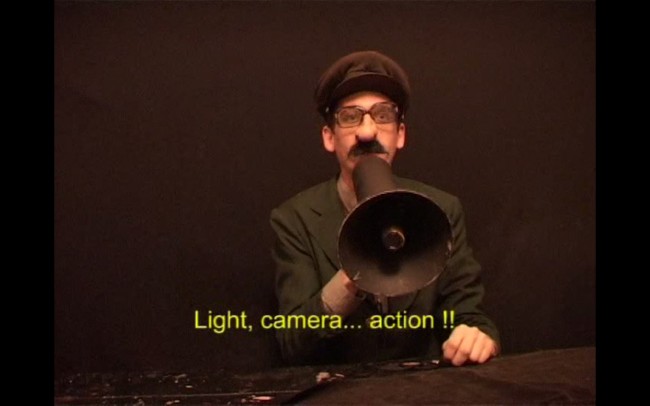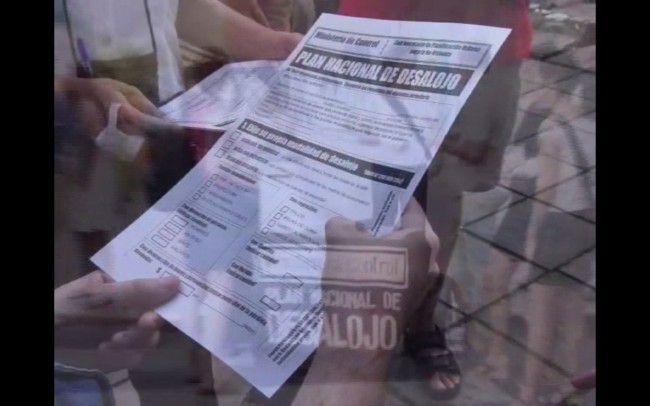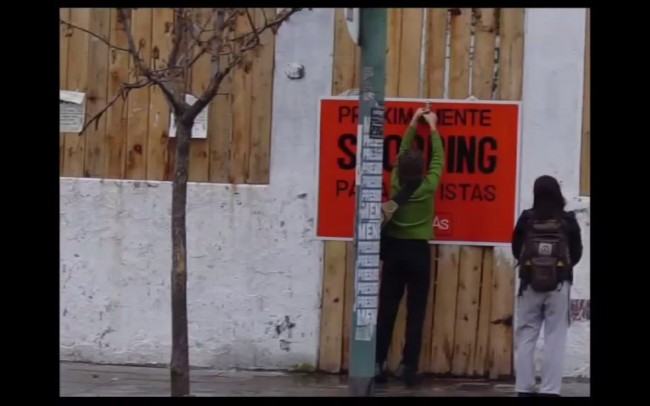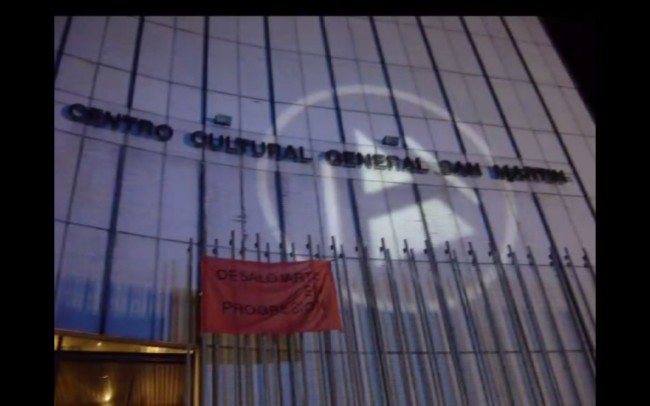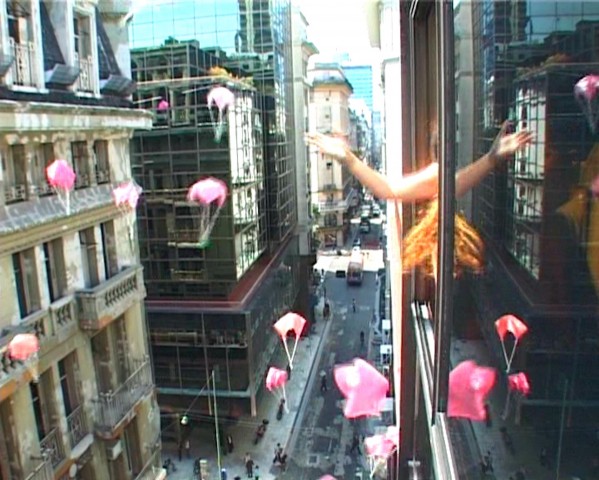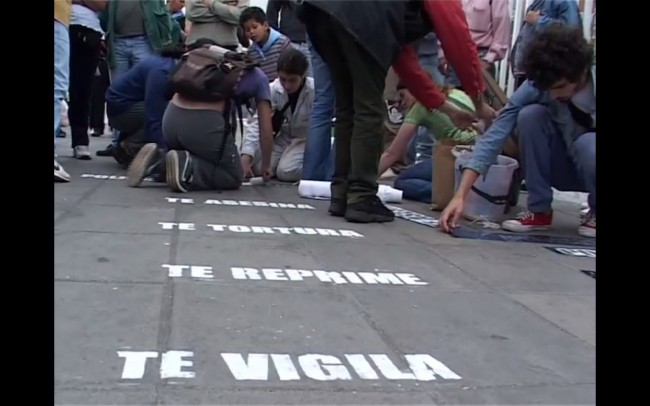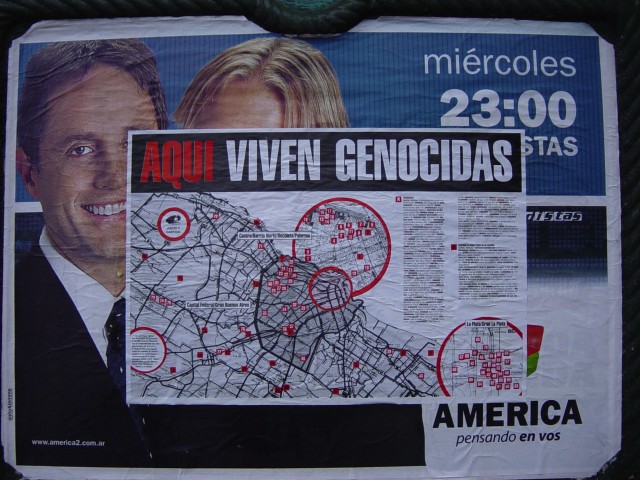At a time of political crisis and spiraling inflation, “between the revolt of December 2001 and President Néstor Kirchner’s inauguration in mid-2003 Argentina experienced an atmosphere of unprecedented institutional instability and ceaseless agitation”. It was a time of intense activism. This section focuses on political artists who were at the forefront of popular protest in Argentina at this time, intervening in public space with performative, graphic and textual acts.
Works by: Grupo de Arte Callejero (founded in 1997, Buenos Aires), Etcetera Group (founded in 1997, Buenos Aires), Kanal B (online, founded in 2000, www.kanalb.org)
1) Etcètera
EtcÈtera TV, 1998-2005
Colour, 24 min
In early November 2005, a security strategy for the IV Summit of the Americas, transformed a 250-block section of the central coast of Mar del Plata into a hermetic enclave. The local residents of the resort could only enter their homes after showing police issued ID cards. The decision makers had decided to isolate themselves, in order to make decisions in the name of those they represent. The main issue was business. Pressure from the Bush government to achieve a continental accord was overpowered by the opposition of the Mercosur countries and Venezuela.
On the morning of the day before the close of the Summit, a peaceful mass demonstration led in spirit by Hugo Chavez, crossed dozens of blocks of one of the unrestricted sectors of the city. That same afternoon, a more radicalized march was programmed to break through one of the few access routes to the military and police cordon that guarded the closed neighborhood where the heads of state were holding their discussions. The conclusion was swift: the police officers deployed a mysteriously moderate repression, some of the demonstrators destroyed stores, there was an arbitrary round-up, dozens of individuals ended up in police stations, and everything was edited and reproduced by the communications media in living color on the news.
During the week of the Summit, Mar del Plata had remained paralyzed. Not a soul was seen on the downtown streets or in the most remote neighborhoods. Local residents who, out of fear, had barricaded themselves for several days in their houses, or had evacuated to neighboring cities, came out into the streets for the first time to review – curiously, confusedly, confoundedly – the trail of destruction that the afternoon’s demonstration had left in its wake.
Mar del Plata, cordoned off under the pretext of a global terrorist threat, while being simultaneously shaken by the street mobilizations, gave birth to a new political movement: The International Errorist (IE).
2) Grupo de Arte Callejero (GAC)
Actions 2001–03
Plan Nacional de Desalojo (National Plan of Eviction), colour, 2’25 minutes
Shopping para Artistas, colour, 1’08 minutes
Desalojarte, colour, 1’32 minutes
Invasion, colour, 3’25 minutes
Lanus, colour, 3’20 minutes
Aqui Viven Genocidas, colour, 10’26 minutes
Since 1997, Grupo de Arte Callejero has been demonstrating in the public spaces of Buenos Aires. The group designs traffic signs and posters and alters logos that mark specific instances of repression. These ‘tools’ are part of a collective action, whose dynamics change according to the subject and context of the intervention.
“We’ve been working for about 8 years with the aim of creating an area in which art and politics form part of the same production mechanism. This is why when defining our work the established barriers between general ideas about militancy and those about art break down. Right from the start we decided to look for a space to communicate visually that was outside the traditional circuit of exhibitions, taking as a base the appropriation of public spaces.”
3) Kanal B
Argentina
60 Minutes, 2004
This 60 min documentary is about how Argentina was systematically ruined by US imperialism and the international financial institutions IMF and the world bank under the label of neo-liberalism, as well as the help of a corrupt political class. The compact and unanimous resistance of the public since the 19th/20th December 2001 has started to stir things up, slowly but surely: people are getting together in neighbourhood meetings, the unemployed are blocking streets, factories are being occupied and run by the workers, the unpunished military men (there were 30,000 missing people during the military dictatorship) and politicians are attacked on the street and openly condemned. The poor – who have no house, no tarmac roads, no money to eat – got to speak out, as well as professors, activists, factory occupants; the people who got together at the meetings.
